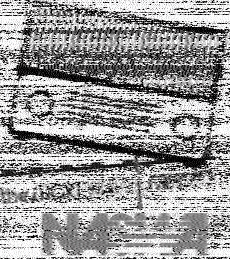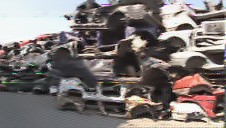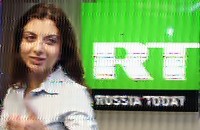
www.rhci-online.net/radiogram/radiogram.htm
|
Am 27.02.2015 um 10:41 schrieb VOA Radiogram: |
|
Hello friends,
The Winter SWL Fest is taking place today and tomorrow (27-28 February) in Plymouth Meeting, Pennsylvania, near Philadelphia. One event during the Fest is "The Annual Spectacular Shortwave Shindig" with David Goren. The Shortwave Shindig will be transmitted by WRMI in Florida UTC Saturday at 0300-0400 (Friday 10-11 pm EST) on 7570 kHz. The Shindig will include, sometime during the hour, an image in MFSK32. There will be no RSID, so have your software set to MFSK32 and centered on 1500 Hz. Send reports to David at shortwaveology@mac.com . |
NO RSID: <<2015-02-28T03:27Z MFSK-32 @ 7570000+1500>>
Sending Pic:230x259;

animation ~ 20s, received ==> original
|
RSID: <<2015-02-28T12:31Z
MFSK-64 @
6095000+1500>>
The grand prize at this year's Winter SWL Fest raffle is the "big
Here's a list of the other prizes: http://www.swlfest.com/2010-prize-list/
|
Internet: |
|
|
RSID: <<2015-02-28T16:01Z
MFSK-32 @
17860000+1500>>
Welcome to program 100 (!) of VOA Radiogram from the Voice of
America.
I'm Kim Andrew Elliott in Washington.
Here is the lineup for today's program, all in MFSK32, except
where indicated:
1:59 Program preview (now)
3:01 Cheaper method of scrap metal separation*
8:51 University students analyze Russia's RT TV*
17:10 Kim's comments about two years of VOA Radiogram*
=======>
text to speech audio
/ BING translator [2,7 MB *.mp3]
26:39 Closing announcements*
28:26 MFSK16: Bonus mode of the week
* with image
Please send reception reports to radiogram@voanews.com.
And visit voaradiogram.net.
Twitter: @VOARadiogram
VOA NEWS
Scrap-Metal Separation May Become Cheaper
George Putic, KI4FNF
February 23, 2015
According to the Environmental Protection Agency, the United
States throws 14.8 million tons of scrap metal into landfills
every year. One of the main reasons is the difficulty of
large-scale separation of non-ferrous metals. Scientists at the
University of Utah now say they have solved that problem.
Recycling metals is much cheaper than extracting them from the
ore. But chopping up old cars, appliances or industrial equipment
results in a mixture of different metal parts.
Iron and steel are easily separated with strong magnets, while
others, such as copper, aluminum and titanium, either end up in
landfills or are shipped to countries with cheap labor to pick
out the different metal by hand.
Researchers at the University of Utah now say they have developed
a method for mechanically separating light metals with high
degree of accuracy.
Don Eggert of O2M Technologies, which partnered with the school
in developing the technology, said the system is based on the
fact that all metals react to a strong magnetic field.
"When the metal falls through the field, even it's non-ferrous,
it's not attracted to the magnet, but the magnet causes there to
be an electric current inside the metal and that causes the metal
to have a magnetic field itself, which interacts with the
magnetic field that it's falling through and pushes it to the
side," said Eggert.
Eggert said rapid change in the frequency of the magnetic field
results in metal pieces falling into different bins.
"So, for example, if we want to separate aluminum and copper we
hit the right frequency for it and the aluminum would push more
away from the magnet than the copper will," he said. "So the
copper falls straight down, the aluminum falls into a different
bucket."
This is just one of the technologies for separating different
metals but Eggert says it is much cheaper to build since it
requires only one large circular magnet and a frequency
controller.
"What we have calculated so far is that the expense to value
ratio -- that is how quickly you can pay back the cost of the
technology over time - we're currently estimating it to be less
than one year."
At the moment, the separator works only with pellets up to one
centimeter wide. Researchers are now building a bigger magnet
with a wider cut to accommodate larger metal parts. They hope to
have it installed at a metal shredding facility sometime this
year, where they will be able to test it in a real-life
environment.
http://www.voanews.com/content/scrap-metal-separation-may-become-cheaper/2655206.html
Image: Screen capture from the video version of this VOA News
story ...
Sending Pic:226x128C;

This is VOA Radiogram from the Voice of America.
Please send reception reports to radiogram@voanews.com.
From Radio Free Europe/Radio Liberty:
'Propaganda Bullhorn' Or 'Alternative Perspective'? U.S. Students
Put Kremlin-Funded RT Under Microscope
By Carl Schreck
February 25, 2015
Few global media outlets elicit such polarized opinions of its
coverage as Russia's state-funded television network RT, which
the United States' top diplomat has called a "propaganda
bullhorn" for the Kremlin during the Ukraine crisis.
Now, a group of graduate students at a leading U.S. journalism
school are in the midst of tracking the network's broadcasts and
online output for a project examining in part whether criticism
of RT as a fountain of Kremlin disinformation is justified.
"Even if Western academics or people in the foreign policy-D.C.
circles chalk the channel off, RT clearly has a significant
audience. And so we felt like, Well, nobody's actually taking a
yardstick and measuring what they're doing. And somebody should
be,'" said Pola Lem, a student at the Columbia University
Graduate School of Journalism in New York City.
Lem and more than a dozen of her fellow students this month
launched a blog called RT Watch as part of the project for a
class titled Audience And Engagement co-taught by Ann Cooper, the
first Moscow bureau chief for National Public Radio (NPR), and
Linette Lopez, the senior finance editor for Business Insider.
The students have dissected RT's coverage of a range of stories,
from send-ups of U.S. Vice President Joe Biden (Finally,
Something RT And U.S. Media Can Agree On, the RT Watch headline
reads) to dispatches from RT war correspondents on the ground in
eastern Ukraine.
Other recent RT Watch posts address the network's rosy spin on
the Russian ruble's travails and Chechen leader Ramzan Kadyrov's
claim that Western nations "spawned" Islamic State militants to
"in order to spark hatred of Islam in the hearts of people all
over the planet."
Abby Martin is a Washington-based correspondent for RT.Abby
Martin is a Washington-based correspondent for RT.
"RT's article dutifully reported Kadyrov's theories with no
skepticism," Casey Michel, a contributor to the project, wrote in
his February 24 post on the network's report.
Michel, a graduate student at Columbia's Harriman Institute for
Russian, Eurasian, and East European Studies, told RFE/RL that
"there's generally a knee-jerk reaction" in any discussion about
RT.
"And I've fallen prey to that as much as anyone in the past, just
dismissing it out of hand. And what we're trying to explore over
the next few weeks is whether that is grounded in some kind of
reality," he said.
The initiative is set to run for several more weeks until the end
of the current semester and will then be picked up by a new group
of students, Cooper told RFE/RL.
More Complex Picture'
Launched in 2005 and previously known as Russia Today, RT has
served as a high-profile platform for conveying the Russian
government's position. The network says it "provides an
alternative perspective on major global events, and acquaints an
international audience with the Russian viewpoint."
RT has come under increasing fire from U.S. and EU officials who
accuse it of disseminating distorted coverage of Russia's
annexation of Ukraine's Crimean Peninsula and the armed conflict
between pro-Russian separatists and Kyiv's forces in eastern
Ukraine.
In April, U.S. Secretary of State John Kerry called the network
"a propaganda bullhorn" deployed by the Kremlin "to promote
[Russian] President [Vladimir] Putin's fantasy about what is
playing out on the ground" in Ukraine.
RT editor in chief Margarita Simonyan responded by expressing
"surprise" that "at this difficult and embarrassing time," Kerry
"has nothing else to worry about apart from our television
channel."
Cooper told RFE/RL that most of what people know about RT likely
comes from "what they've read in mainstream-media articles, where
the operative line is Kremlin propaganda arm.'"
"I think the articles go on to make their case for using that
phrase. But I think there's more to this. It's a more complex
picture," she said.
http://www.rferl.org/content/rt-propaganda-columbia-journalism-students-blog-coverage/26869048.html
Image: Margarita Simonyan, editor in chief of RT ...
Sending Pic:200x130C;

This is VOA Radiogram from the Voice of America.
Please send reception reports to radiogram@voanews.com.
The following is my International Broadcasting column for the
=======>
text to speech audio
/ BING translator [2,7 MB *.mp3]
March 2015 Journal of the North American Shortwave Association
(NASWA) ...
VOA Radiogram: Two years of strange noises on shortwave
Kim Andrew Elliott
March 2015 will mark two years of VOA Radiogram, the weekly Voice
of America program in which digital text and image modes are, as
illogical as it may seem, broadcast by an analog shortwave
broadcast transmitter.
A few years ago I was aware that more and more countries were
devising more and more ways to block Internet content. At the
same time, as a radio amateur, I was becoming active in the
digital modes. I was amazed at how well the digital modes, many
with built-in error correction, could cope with difficult HF
conditions.
In a rare flicker of inspiration, I thought of using digital
modes on shortwave to transmit text and images, the building
blocks of web pages, into countries where the Internet is
censored.
However, at the time, I thought that the digital modes had to be
transmitted and received in single sideband, because that's how
the hams do it. An engineering colleague set me straight: the
digital modes are conveyed via audio, and audio can be
transmitted by AM as well as SSB.
That revelation meant that the digital modes could be transmitted
on any existing analog AM shortwave broadcast transmitter. And it
could be received even on inexpensive portable shortwave radios
with no SSB capability. Digital Radio Mondiale (DRM), on the
other hand, needs a new transmitter, or at least a new exciter,
and a special (and these days hard to find) receiver.
How to decode the modes
To decode the VOA Radiogram content, audio from the plain or
fancy receiver must be patched into a personal computer. (In a
pinch, the radio's speaker can be placed next to the built-in mic
of a laptop PC.) Software does the decoding. Most VOA Radiogram
listeners use Fldigi from w1hkj.com, but other decoding software,
such as MultiPSK and DM780, is available.
The concept was first tested on WBCQ and WRMI. In March 2013, the
new VOA Radiogram program went on the air, transmitted from a
50-year-old GE transmitter, using 80 kilowatts, at the IBB
Greenville, NC, site.
Thousands of reception reports have so far been received from
shortwave listeners and radio amateurs. Most are located in
Europe and North America, but some are in Latin America and Asia.
Most weekends, VOA Radiogram is successfully decoded by a
listener in New Zealand, 14000 km from the transmitter.
MFSK is the best, so far
In the first weeks of VOA Radiogram, the various digital modes
available to amateur radio were tested side by side. These modes
included the various flavors and speeds of BPSK, QPSK, MT63,
Olivia, and Thor. It was, however, MFSK that provided the most
successful text decodes. And, as a bonus, MFSK can also be used
to transmit images, in a manner similar to slow scan television
(SSTV).
In addition to the decision about the mode was the question of
the speed of the mode. As a general rule, the faster the mode,
the less able it is to cope with difficult shortwave conditions.
MFSK16 (as in 16 baud) is amazingly robust in dreadful
conditions, but slow at 55 words per minute. MFSK64 is 240 wpm
but works well only in favorable conditions. MFSK128, at 480 wpm,
is blisteringly fast but really best suited for local VHF and
UHF. Ultimately, MFSK32 demonstrated the best combination of
speed (120 wpm) and performance in typical, i.e. usually not
brilliant, shortwave conditions.
Extends the range of (what's left of) shortwave broadcasts
Reception reports and audio files received from listeners
indicate that MFSK32 not only works well, it works better than
voice on analog shortwave. In conditions where a typical voice
broadcast is difficult to comprehend, e.g. my voice introduction
to each VOA Radiogram, the text is often copied 100%. Thus, the
introduction of software has extended the communications
capability of shortwave broadcast transmitters, just at a time
when those transmitters are being dismantled at an alarming rate.
If a country blocks our Internet content, it will probably also
jam our shortwave broadcasts. The text modes have been tested
against Chinese jamming of VOA and Radio Free Asia, and Cuban
jamming of Radio Marti. Remote receivers in or near the target
countries show the text modes slicing through some intense
jamming.
MFSK32 occupies only about 500 Hz of the 2000 Hz bandwidth
available in each sideband of an AM shortwave signal. New modes
in development use all of that available 2000 Hz, to some extent
for additional speed, but even more for additional error
correction. This would result in a text delivery technology
especially well- suited to shortwave broadcasting, and perhaps
even more resistant to jamming.
Now we need hardware and software solutions
It would be helpful if more of the surviving shortwave broadcast
stations would transmit text and images, even just a few minutes
per week. This would encourage software developers and receiver
manufacturers to facilitate the reception of these modes. The
Elecraft K3 amateur transceiver decodes the popular PSK31 mode
and shows the text on the rig's display, so receivers could also
do this with other modes.
Fldigi and the other decoding software now used by VOA Radiogram
listeners are really designed for amateur radio use. They include
several features, such as encoding, not needed for receive-only
use and intimidating to the non-technical. Therefore, a vital
requirement is the development of a software app that would
simplify the decoding process and make it possible on mobile
devices as well as PCs.
For more information about the North American Shortwave
Association, visit http://www.naswa.net.
Sending Pic:171x51C;

Please send reception reports to
radiogram@voanews.com.
And visit voaradiogram.net.
Twitter: @VOARadiogram
Thanks to colleagues at the Edward R. Murrow shortwave
transmitting station in North Carolina.
I'm Kim Elliott. Please join us for the next VOA Radiogram.
This is VOA, the Voice of America.
Sending Pic:380x30C;
![]()
RSID: <<2015-02-28T16:28Z
MFSK-16 @ 17860000+1500>>
Thank you for your support during these first 100 programs of VOA
Radiogram.
www.rhci-online.net/radiogram/radiogram.htm
|
QTH: |
D-06193 Petersberg (Germany/Germania) |
|
|
Ant.: |
Dipol for 40m-Band & Boomerang Antenna 11m-Band |
|
|
RX for RF: |
FRG-100B + IF-mixer & ICOM IC-R75 + IF-mixer |
|
|
Software IF: |
con STUDIO1 - Software italiano per SDR [S-AM-USB/LSB] |
|
|
Software AF: |
||
|
OS: |
German XP-SP3 with support for asian languages |
German W7 32bit + 64bit |
|
PC: |
MEDION Titanium 8008 (since 2003) [ P4 - 2,6 GHz] |
MSI-CR70-2MP345W7 (since2014) [i5 -P3560 ( 2 x 2,6GHz) ] |
DRM-images - received via EASYPAL/DSSTV on 14233kHz/USB (FRG-100 / Dipol for ~12 MHz)
Here are some pics of 2E1HOL [Dave Field, Shirebrook, NG208LL MANSFIELD NOTTS / England/UK] received in the last time.
|
|
|
|
|
|
|
|
|
|
|
|
|
|
|
|
|
|
|
|
|
|
|
|
|
|
|
|
|
|
|
|
|
|
|
|
|
|
|
|
|
|
|
|
|
|
|
|
|
|
|
|
|
|
|
|
|
|
|
|
|
|
|
|
|
|
|
|
|
|
|
|
|
|
|
|
|
|
|
|
|
|
|
|
|
|
|
|
|
|
|
|
|
|
|
|
|
|
|
|
|
|
|
|
|
|
|
|
|
|
|
|
|
|